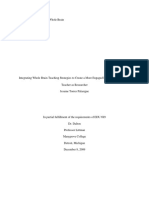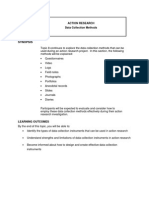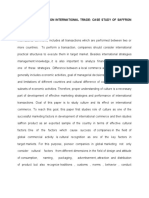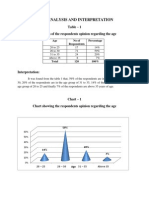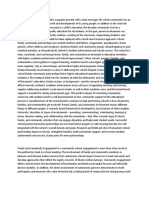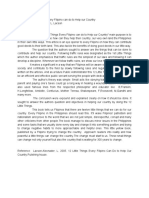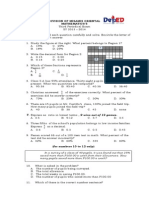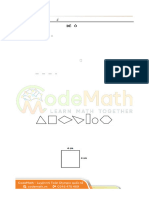Action Research
Action Research
Uploaded by
Rosidah HidayatCopyright:
Available Formats
Action Research
Action Research
Uploaded by
Rosidah HidayatCopyright
Available Formats
Share this document
Did you find this document useful?
Is this content inappropriate?
Copyright:
Available Formats
Action Research
Action Research
Uploaded by
Rosidah HidayatCopyright:
Available Formats
WHAT IS ACTION RESEARCH Action research has an applied focus.
Similar to mixed methods research, action research uses data collection based on either quantitative or qualitative methods or both. However, it differs in that action research addresses a specific, practical issue and seeks to obtain solutions to a problem. Thus, action research designs are systematic procedures done by teachers (or other individuals in an educational setting) to gather information about, and subsequently improve, the ways their particular educational setting operates, their teaching, and their student learning (Mills, 2000). Educators aim to improve the practice of education by studying issues or problems they face. Educators reflect about these problems, collect and analyze data, and implement changes based on their findings. In some cases, the research solves a local, practical problem, such as a classroom issue for a teacher. In other situations, the researcher seeks to empower, transform, and emancipate individuals from situations that constrain their self-development and selfdetermination.
WHEN DO YOU USE ACTION RESEARCH You use action research when you have a specific educational problem to solve. This problem may be the difficulties facing pact-time faculty (Watters, Christensen, Arcodia, Ryan, & Weeks, 1998), ascertaining whether problembased learning is superior to the traditional lecture (Dods, 1997), or discovering how literacy in writing emerges for first-grade students (Ceprano & Garan, 1998). Action research provides an opportunity for educators to reflect on their own practices. Within the scope of a school, action research offers a means for staff development, for teachers' development as professionals, and for addressing schoolwide problems (Allen & Calhoun, 1998). In fact, the scope of action research provides a means for teachers or educators in the schools to improve their practices of taking action and to do so by participating in research.
HOW DID ACTION RESEARCH DEVELOP? Three stages mark the development of action research. The first stage consists of the identification of a process for addressing societal issues. The second stage turns toward practice and the need to involve practitioners, such as teachers, in the solution to their own problems. The third and most recent phase represents the participatory, emancipatory, or community action research approach in which groups assume responsibility for their own emancipation and d hange. The social-psychologist Kurt Lewin coined the term -action research in the 1930s (Mills, 2000). Lewin felt that social conditions in the 1940ssuch as the shortage of meat, the need for aerial reconnaissance during World War II, and the improvement of intercultural group relations after the warmight be enhanced through the process of group discussions (Kemmis, 1994). These group processes consisted of four steps: planning, acting, observing, and reflecting. By focusing on group processes and identifying phases of action, Lewin's approach introduced many of the modern ideas of action research: a process of steps, participation, the democratic impulse of involvement, and the contribution to social change (Kemmis, 1994). Spreading from the social sector to education, Lewin's ideas were adopted at the Horace-Mann-Lincoln Institute at Teachers College, Columbia University, and in England at the Tavistock Institute. This spread of action research slowed during the mid- to late 1950s. The growing gulf between theory and practice, the emphasis on research development in regional educational I,rho-atories, and the emphasis on experiments and systematic research all contributed to this decline. Then, in the 1970s, action research projects in Great Britain, the United States, and Australia reemerged. For example, the Fort Teaching project in England focused on teachers studying their own practices. The Classroom Action Research Network at the Cambridge Institute of Education in Great Britain addresses practical issues between teachers and students. Team-based inquiry between researchers and the schools emerged at Columbia University in the United States. The emancipation of individuals in education based on the German writings of Habermas became the focus of inquiry
by the Australian Stephen Kemmis and his colleagues (Kemmis & McTaggart, 2000). Having teachers study their own classroom problems and issues has emerged as an important direction for school renewal today. As shown in Figure 18.1, the movement toward action research has evolved from the in-service days of the 1970s to the site-based plans for staff development during the 1980s to the present emphasis on educators reflecting on their own practices (Schmuck, 1997). Reasons cited today for the importance of action research reinforce these trends. Action research: Encourages change in the schools Fosters a democratic (i.e., involvement of many individuals) approach to education Empowers individuals through collaboration on projects Positions teachers and other educators as learners who seek to narrow the gap between practice and their vision of education Encourages educators to reflect on their practices Promotes a process of testing new ideas (Mills, 2000)
Although action research has gained support in education, it is not without critics, who are reluctant to view it as a legitimate form of inquiry'(Stringer, 1999). Some view it as an informal process of research, conducted by teachers and other educators who are not formal academic researchers. The practical aspect of action research also suggests an applied orientation to this form of inquiry with a Iess than scientific approach. Action researchers typically report results of their studies not to scholarly journals in education, but to online journals, Web sites, or local school groups. The methods are adapted and changed in response to the practitioners' objectives to understand a practical problem. Hence, the design may not have the rigor and systematic approach found in other designs. Despite these concerns, action research fulfills an important role for the teacher-researcher and school-based teams formed to study local school issues. It also provides a design that encourages collaboration among school and community participants to help transform schools and educational practices.
WHAT ARE THE TYPES OF ACTION RESEARCH DESIGNS?
Action research means different things to different people, and some writers hold limited views as to what counts as action research Matters et al., 1998). A review of the major writers in education, however, shows that the following two basic research designs are typically discussed (Mills, 2000): Practical action research Participatory action research
As you read about these two forms of action research, the overview of their differences shown in Figure 18.2 will help you distinguish between their major features.
Practical Action Research Teachers seek to research problems in their own classrooms so that they can improve their students' learning and their own professional performance. Teams comprised of teachers, students, counselors, and administrators engage in action research to address common issues such as escalating violence in school. In these situations, educators seek to enhance the practice of education through the systematic study of a local problem. This form of action research is called practical action research, and its purpose is to research a specific school situation with a view toward improving practice (Schmuck, 1997). Practical action research involves a small-scale research project, narrowly focuses on a specific problem or issue, and is undertaken by individual teachers or teams within a school or school district. Examples of practical action research studies include these: An elementary teacher studies the disruptive behavior of a child in her classroom. A team composed of students, teachers, and parents studies the results of implementing a new math program in the junior high. A community college instructor studies his professional development using technology in teaching
In all of these examples, action research seeks to improve specific, local issues. It calls for educators to involve teachers in research to study concerns in their own schools or classrooms and to implement site-based councils or committees in schools to enhance research as an integral part of daily classes and education. In this spirit, educators can test their own theories and explanations about learning, examine the effects of their practices on students, and explore the impact of approaches on parents, colleagues, and administrators within their schools. A drawback of this approach is that although teachers seek to improve their classroom practices, they have little time to engage in their own research. Although teachers may be good at what they do and familiar with teaching kids in classes, they may need assistance: in becoming researchers. To this end, they can participate in graduate classes, which will help them renew or develop the requisite skills for inquiry required in an action research project (e.g., Hughes, 1999; Kosnik, 1996). To understand practical action research, we need to review its major ideas or principles. As identified by Mills (2000), the following principles focus on assumptions about the role of teachers as learners, as reflective practitioners, and as individuals engaging in small-scale research projects: Teacherresearchers have decision-making authority to study an educational practice as part of their own ongoing professional development. Teacherresearchers are committed to continued professional development and school improvement, a core assumption for any teacher who decides to engage in action research. Teacherresearchers want to reflect on their practices. They reflect so that they can improve their practices. They reflect individually or in schoolbased teams t omposed of students, teachers, and administrators. Teacherresearchers use a systematic approach for reflecting on their practices, meaning that they use identifiable procedures to study their own problems rather than using a random, anything-goes design.
Teacherresearchers will choose an area of focus, determine datacollection techniques, analyze and interpret data, and develop action plans.
This final point refers to the process of research. The books about practical action research advance detailed steps that teachers and other educators might use to conduct a study. Mills (2000), for example, discusses several of these models, then advances his own and uses it as the framework for chapters in his book. He calls his model the dialectic as tion research spiral. This model, shown in Figure 18.3, provides teachers with a four-step guide for their action research project. Mills emphasizes that it is a model for teachers to use to study themselves, not a process of conducting research on teachers. It is a "spiral" because it includes four stages where investigators cycle back and forth between data collection and a focus, and data collection and analysis and interpretation. In this procedure, the teacher-researcher identifies an area of focus. This process involves defining an area of focus, doing reconnaissance (self-reflection and description), reviewing the literature, and writing an action plan to guide the research. Then the teacher-researcher collects data by}gathering multiple sources of data (quantitative and qualitative) and by using a variety of inquiry tools, such as interviews, questionnaires, or attitude scales. Data collection also; consists of attending to issues of validity, reliability, and ethics, such as provisions for informed consent. The action researcher follows this phase with analysis and interpretation. The process includes identifying themes; coding surveys, interviews, and
questionnaires; asking key questions; doing an organizational review; engaging in concept mapping (i.e., visualizing the relationship of ideas); analyzing antecedents and consequences; and displaying findings. Interpretation involves extending the analysis by raising questions, connecting findings to personal experiences, seeking the advice of critical friends, and contextualizing the findings in literature and theory. In the final stage, the teacher-researcher finally completes an action plan or chart. This chart includes a summary of findings, recommended actions, and the identification of individuals responsible for action and individuals who need to be
consulted and informed. The chart also indicates who will monitor and collect the data, the timeline for data collection, and the resources needed to carry out the action. Overall, this process eniphasizes practical action research centered around studying a local problem, engaging in" inquiry by an individual teacher (teacheras-researcher) or a team, and focusing on teacher development. A review of an actual study can illustrate this practical approach to actin research. Hughes (1999) was a fourth-grade teacher in a small country-suburban K-8 district school. She begins by describing her class and the problem of not having in-class support for high-ability students in her room. The gifted students were pulled out of her classroom daily during math instruction to work on special science projects. In view of this, she wondered whether she was meeting the needs of these high-ability students, and she initiated an action research study. Here were the steps she took: 1. She first reviewed the published literature on her issue (e.g., pull-out programs, inclusion of gifted in the classroom, and meeting the needs of the gifted). 2. In addition, she interviewed colleagues from her school and neighboring elementary schools for their perspectives. 3. From the literature review and her interviews, she identified four themes school reform, enrichment'versus acceleration, pull-out versus in-class, and new educational strategiesand developed a flowchart listing the factors that surfaced for each theme, such as: school reform-movement ideas equity for allevery child receives what he or she needs to grow and learn, and not every child receives the exact same instruction excellence for all where every child is challenged to the limit of his or her abilities (Hughes, 1999, p. 284). 4. Based on this information, she refined her original research questions and collected both quantitative and qualitative data through parent telephone interviews, student surveys, teacherconferences with students about their
work portfolios, and classroom observations by six different teachers for each 'question. She placed this information in a chart so that her team members could help her analyze the data. 5. She enlisted six other elementary teachers from her building to create a team to help with the process of data analysis. 6. The team first skimmed the data to obtain a clear picture of it and then sorted all of the data under four themes about how to incorporate gifted children into the class (in-class flexible groups, differentiated instruction, enrichment, and acceleration). 7. She turned these themes into four major activities for the teacher to try in her classroom. 8. Next ,she put the findings into an action plan, resulting in specific activities (e.g., continue to self-evaluate and find ways to incorporate differentiated instruction and assessment in the classroom). 9. She shared her findings with others, to "make a difference on a larger scale" (Hughes, 1999, p. 2.95). This included sharing her study with other fourth-grade teachers, her principal, and a district committee. 10. The study ended with Hughes reflecting on future questions that she needed answered, such as "Which is better, pull-out programs, in-class programs, or a combination?" These 10 steps illustrate a good practical action research study in which a teacher collaborates to study a local problem, develops as a professional, uses a systematic approach to inquiry (e.g., gathering and analyzing data), and implements a plan of action. Partisipatory Action Research Participatory action research (PAR) has a long history in social inquiry in solving communi-ties,Andustries and corporations, and other organizations outside of education (e.g., Whyte, 199< ). Rather than a focus on individual teachers solving immediate classroom problems or schools addressing internal issues, PAR has a social and community orientation and an emphasis on research that contributes to emancipation or change in our society. Drawing on the work of the South
American Paulo Freire, the German critical theorist Jurgen Habermas, and more recently Australians Stephen Kemmis and Ernest Stringer (Schmuck, 1997), this approach has emerged as an action-oriented, advocacy means of inquiry. Often PAR includes qualitative data collection, but it may also involve quantitative data collection. Individuals refer to participatory action research by different names, such as community-based inquiry (Stringer, 1999, p. 9), collaborative action research or participatory research (Kemmis & Mciaggart, 2000, p. 567), or critical action research (Mills, 2000, p. 7). To acknowledge the collaborative nature of this type of inquiry, this chapter uses the term participatory action research. The purpose of participatory action research is to improve the quality of people's organizations, communities, and family lives (Stringer, 1999). Although espousing many of the ideas of teacher and school-based practical action research, it differs by incorporating an emancipatory aim of improving and empowering individuals and organizations in educational (and other) settings. Applied to education, the focus is on improving and empowering individuals in schools, systems of education, and school communities. PAR also has a distinct ideological foundation that shapes the direction of the process of inquiry in the type of issue that commands attention of the action researcher; in the procedures of research, especially data collection; and in the intent and outcomes of the inquiry. For example, participatory action researchers study issues that relate to a need to address social problems that constrain and repress the lives of students and educators. For example, consider these issues that address social, economic, political, and class problems in our society that may be the focus of a PAR study: Tests that label and stereotype students Texts that omit important historical persons or events of cultural and ethnic groups Assessments that serve to confirm student failure rather than learning K12 classroom interactions that silence or quiet the voices of minority students
In addition to studying these sensitive issues, the participatory action researcher also engages in a process of research that promotes egalitarian and democratic aims. Participatory action researchers strivq for an open, broad-based involvement of participants in their studies by collaborating in decisions as consensual partners and engaging participants.as equals to ensure their well-being. For example, in their inquiries, researchers emphasize the importance of establishing contacts, identifying stakeholder groups, identifying key people, negotiating the researcher's role, and building a preliminary picture of the field' context of the study (Stringer, 1999). The social values of liberation and life-enhancing changes also are important, and action researchers seek to bring about a new vision for schools, community agencies, youth clubs, and ethnic groups within schools. Kernrnis and Wilkinson (1998) summarized six central features of PAR: 1. PAR is a social process in which the researcher deliberately explores the relation-ship between the individual and other people. The object is to understand how social interaction forms and reforms individuals. Applied to education, participatory action researchers might explore teachers working together in teams. 2. This form of inquiry is participatory. This means that individuals conduct studies on themselves. During 'this process, people examine how their own understandings, skills, values, and present knowledge both frame and constrain their actions. Teachers, for example, would study themselves to gain a better understanding of their practices and how this knowledge shapes land constrains) their work with students. 3. This form of research is practical and collaborative. It is collaborative because it is inquiry completed with diners. It is practical because researchers typically explore acts of communication, the production of knowledge, and the structure of social organization to reduce irrational, unproductive, unjust, or unsatisfying interactions. Teachers, for example, might collaborate with other teachers to reduce the unproductive and unsatisfying levels of bureaucracy in a school that might inhibit classroom innovations.
4. PAR is emancipatory in that it helps unshackle people from the constraints of irrational and unjust structures that limit self-development and selfdetermination. The intent of a study, for example, might be to change the bureaucratic procedures for teachers in schools so that they can better facilitate student learning. 5. One intent of PAR research is to help individuals free themselves from constraints found in the media; in language, in work procedures. and in the relationships of power in educational settings. For instance, teachers may be constrained by a subservient role in the schooldistrict so that they do not feel empowered in their classrooms. 6. PAR is recursive (reflexive or dialectical) and focused on bringing about change in practices. -his occurs through spirals of reflection and action. When teachers reflect on their roles in schools, they will try one action and then another, always returning to the central question of what they learned and accomplished because of their actions. A spiral of looking, thinking, and action best reflects the action research process. This process, called the interacting spiral by Stringer (1999), is shown in Figure 18.4. This model contains three phases: look, think, and act. The spiral of this model conveys that action research is not neat, orderly, and linear, but is a process of repeating and revising procedures and interpretations. Let's examine more closely the components of the action research process for looking, thinking, and acting. The detailed analysis of the three phases is shown in Figure 18;5. In this model, Stringer (1999) placed emphasis on the importance of "looking" to build a picture to help stakeholders understand issues they are experiencing. The "look" phase consists of collecting data (e.g., through interviews, observation, and documents), recording and analyzing the information, and constructing and reporting to stakeholders about the issue. The "think" phase then moves into interpreting the issues in greater depth and identifying priorities for action. In the final phase, the researcher identifies the "act" phase: devising practical solutions to the problems. This involves devising a plan and setting dir titan, such as objectives, tasks, and persons to carry out the objectives and secure
needed resources. It also means implementing the plan, encouraging people to carry it out, and evaluating it in terms of its effect and achievements. Let's examine a PAR study to see this process at work. Stanulis and Jeffers (1995) studied the mentoring relationship between a fifth-grade classroom teacher (Lynn), her student teacher (Shawna), and a university coordinator (Randi). Called critical action research, the authors described Lynn's mentoring of Shawna. Randi, as the coordinator of field experiences and a university mentor, worked with Lynn to compile data to assess her mentoring of the student teacher. They collected three sets of data to explore this mentoring: Five videotaped conferences were recorded between the student teacher and the classroom teacher every other week during a 10-week period. Weekly personal journal entries of the classroom teacher and the student teacher were reviewed. Five interviews were conducted by the university coordinator with the classroom teacher and the student teacher using the method of individual stimulated recall, a procedure of viewing the videotapes and answering interview questions (e.g., "Was there a point in the conference that you chose not to say something?"). Based on this data, the university coordinator and the classroom teacher identified four themes: (a) the process in which the student teacher gained the students' respect, (b) how the student teacher learned about the children as a learning community (e.g., their family backgrounds, their interests), (c) the mentoring relationship between the student teacher and the classroom teacher, and (d) ideas learned from action research. Consistent with participatory action research, the authors mentioned that the student teacher brought to the classroom issues of knowledge and authority. The mentoring teacher viewed authority, embedded within the structure of the studentteaching experience, as shifting and changing during the course of the experience. The mentoring began as a spring-board where the teacher told and shared how to teach the children and shifted to the mentor teacher serving as someone to listen and help clarify the student's ideas. The semester ended with the student teacher
and mentor teacher viewing each other as colleagues, sharing ideas, and, in the process, loosening the constraints of teacher authority lodged within a studentteaching experience. They changed and transformed the mentoring relationship during this work togethera result consistent with PAR. Also, in the student teacherteacher conferences, the opportunity to reflect on each individual's approach to teaching provided collaboration and reflection before at ion. Each individual, as well, learned about himself or herself and became sensitive to changes in the teacherstudent relationship. As you think back on Maria's action research project where she addresses the question "What steps 'can our school take to encourage students to be more concerned about the possession of weapons in the school?" should she use practical action research or PAR as her approach? Please provide three reasons for your choice.
You might also like
- Education of Psychology - Windows On ClassroomsDocument39 pagesEducation of Psychology - Windows On ClassroomsPJ Gape40% (5)
- Primary Sources of Data and Secondary Sources of Data: September 2017Document6 pagesPrimary Sources of Data and Secondary Sources of Data: September 2017Tejaswini RoutNo ratings yet
- Math Paper 3 PracticeDocument21 pagesMath Paper 3 PracticeRaahish KalariaNo ratings yet
- Research Template For G12 QNR PDFDocument4 pagesResearch Template For G12 QNR PDFJohn Paul Castillo VallenteNo ratings yet
- Sample Thesis Chapter 2Document13 pagesSample Thesis Chapter 2porple123100% (2)
- Action-Research-Oral-Language-Skills-for-Grade Three-PupilsDocument43 pagesAction-Research-Oral-Language-Skills-for-Grade Three-PupilsEr MaNo ratings yet
- ORELT - Module 5 - Modified - 0 PDFDocument80 pagesORELT - Module 5 - Modified - 0 PDFEmil KosztelnikNo ratings yet
- Student Classroom Misbehavior - An Exploratory Study Based On Teachers' Perceptions PDFDocument9 pagesStudent Classroom Misbehavior - An Exploratory Study Based On Teachers' Perceptions PDFAdam AzlanNo ratings yet
- Whole Brain System-2Document24 pagesWhole Brain System-2danny maribaoNo ratings yet
- Research ImportanceDocument4 pagesResearch ImportanceRimaQuitain100% (1)
- Effects of Depression On Students Academ PDFDocument6 pagesEffects of Depression On Students Academ PDFKristine Dela CruzNo ratings yet
- Directed Reading Thinking Activity (Drta) On Students' Reading ComprehensionDocument69 pagesDirected Reading Thinking Activity (Drta) On Students' Reading ComprehensionIfnu SyariffudinNo ratings yet
- A Conceptual Framework of The Evolution of School PsychologyDocument17 pagesA Conceptual Framework of The Evolution of School PsychologyFernandoNo ratings yet
- Classroom Based ResearchDocument13 pagesClassroom Based Researchrotiboy boyNo ratings yet
- A Study On The Understanding of Grammar Among English Major Students at The University of Tripoli, Faculty of LanguagesDocument17 pagesA Study On The Understanding of Grammar Among English Major Students at The University of Tripoli, Faculty of Languagespilam arroyoNo ratings yet
- Topic 8 Action Research Data Collection MethodsDocument10 pagesTopic 8 Action Research Data Collection MethodsFatin Syazwani100% (2)
- What Is Action ResearchDocument4 pagesWhat Is Action ResearchsembeNo ratings yet
- Effect of Culture On International TradeDocument14 pagesEffect of Culture On International TradeKhizra ZahidNo ratings yet
- 100 Research Paper Topics Ideas For 2017 CompressDocument30 pages100 Research Paper Topics Ideas For 2017 CompressAlbert AciertoNo ratings yet
- Differentiated Instruction Literature ReviewDocument6 pagesDifferentiated Instruction Literature Reviewapi-437407548No ratings yet
- A Reflection Essay On Chapter 1 "Teaching and Educational Psychology" in Ormrod (2011) - Educational PsychologyDocument7 pagesA Reflection Essay On Chapter 1 "Teaching and Educational Psychology" in Ormrod (2011) - Educational Psychologyakhatib_11100% (2)
- Hmef5113 QuestionaireDocument3 pagesHmef5113 QuestionairenmrasaNo ratings yet
- Application Letter English For Specific PurposesDocument14 pagesApplication Letter English For Specific PurposesShelly RosyalinaNo ratings yet
- Peer AssessmentDocument20 pagesPeer AssessmentDzulfikar Lazuardi MasyhuriNo ratings yet
- Data Analysis and Interpretation: Table - 1 Distribution of The Respondents Opinion Regarding The AgeDocument24 pagesData Analysis and Interpretation: Table - 1 Distribution of The Respondents Opinion Regarding The AgeRaja MadhanNo ratings yet
- Research Project Group 2Document77 pagesResearch Project Group 2dinodinodeveraNo ratings yet
- Factors Affecting Students Writing Skill PDFDocument54 pagesFactors Affecting Students Writing Skill PDFNumera khanumNo ratings yet
- I T Takes A Village To Raise A Child Is A Popular Proverb With A Clear MessageDocument3 pagesI T Takes A Village To Raise A Child Is A Popular Proverb With A Clear MessageChlea Marie Tañedo AbucejoNo ratings yet
- What Is Action ResearchDocument17 pagesWhat Is Action ResearchGabriel TafallaNo ratings yet
- DedicationDocument13 pagesDedicationgovanank7876No ratings yet
- Cooperative LearningDocument7 pagesCooperative LearningeverNo ratings yet
- Campus Journalism Act of 1991Document7 pagesCampus Journalism Act of 1991Dennis Esik Maligaya100% (1)
- Chapter 2 - Research MethodologyDocument6 pagesChapter 2 - Research MethodologyJona D'johnNo ratings yet
- 08 Chapter 2Document22 pages08 Chapter 2ananthakumarNo ratings yet
- Effectiveness of Banning Cellphones Inside The Campus of Saint Joseph High School of Talakag, Inc.Document33 pagesEffectiveness of Banning Cellphones Inside The Campus of Saint Joseph High School of Talakag, Inc.Mary Demms Zusette CasinabeNo ratings yet
- Vak Learning Styles ModelDocument7 pagesVak Learning Styles ModelIttzel Gonzalez Santiago100% (1)
- Chapter 1 Introduction - Art CriticismDocument51 pagesChapter 1 Introduction - Art CriticismRohazlina HassimNo ratings yet
- Chapter 3Document8 pagesChapter 3YsabelleeeeeNo ratings yet
- Action ResearchDocument962 pagesAction ResearchVannellope's Infinity Dress94% (16)
- Review of LiteratureDocument24 pagesReview of LiteratureAravindh RamuNo ratings yet
- Schema Theory Is One of The Theories of Second Language Acquisition To LearnersDocument3 pagesSchema Theory Is One of The Theories of Second Language Acquisition To LearnersTyas Cho0% (1)
- Research TopicDocument3 pagesResearch TopicMarissa AdraincemNo ratings yet
- DissertationDocument240 pagesDissertationJamey Tobery-NystromNo ratings yet
- Or You May Specify Your Steps Following The Format I Gave You.Document10 pagesOr You May Specify Your Steps Following The Format I Gave You.Christine Teofilo DeiparineNo ratings yet
- Motivational Teaching Strategies Among TeachersDocument103 pagesMotivational Teaching Strategies Among TeachersHiezl Ness Gonzaga100% (1)
- Essay About Education: A ReviewDocument3 pagesEssay About Education: A ReviewFraynerNo ratings yet
- Social Learning TheoryDocument1 pageSocial Learning TheorySherry Mae ArmadaNo ratings yet
- Project Method of TeachingDocument1 pageProject Method of TeachingAliza SaherNo ratings yet
- Factors Affecting EntrepreneurshipDocument9 pagesFactors Affecting EntrepreneurshipWasifNo ratings yet
- EDUC. 3 Midterm Module 6Document11 pagesEDUC. 3 Midterm Module 6MA EDYLYN NOGUERRANo ratings yet
- QuestionareDocument9 pagesQuestionareJhon Devon LargoNo ratings yet
- The Role of Constructivism in Teaching and Learning ChemistryDocument12 pagesThe Role of Constructivism in Teaching and Learning ChemistryKelly EweNo ratings yet
- Lanscile Tulod - Book Analysis: 12 Little Things Every Filipino Can Do To Help Our CountryDocument1 pageLanscile Tulod - Book Analysis: 12 Little Things Every Filipino Can Do To Help Our CountryLanscile TulodNo ratings yet
- III Research Final-1Document54 pagesIII Research Final-1Katrina Kayla De CastroNo ratings yet
- What Is A Survey in Research Paper?Document3 pagesWhat Is A Survey in Research Paper?Joyce Ann MauricioNo ratings yet
- Differences Between Qualitative and Quantative ResearchDocument8 pagesDifferences Between Qualitative and Quantative ResearchLori Perez100% (1)
- Sample of Chapter 5Document4 pagesSample of Chapter 5Kezia Nueva PangaralNo ratings yet
- Tourism Involvement, Work Engagement and Job Satisfaction Among Frontline Hotel EmployeesDocument26 pagesTourism Involvement, Work Engagement and Job Satisfaction Among Frontline Hotel EmployeesRatna BaliNo ratings yet
- Action ResearchDocument11 pagesAction Researchshuqairi83840% (2)
- Roles of AssessmentDocument4 pagesRoles of AssessmentRoiz HipolitoNo ratings yet
- Handbook of Research on TeachingFrom EverandHandbook of Research on TeachingCourtney BellNo ratings yet
- Ed 504400Document17 pagesEd 504400givemoreshonhiwa604No ratings yet
- 100 Functional Equations Problems-OlympiadDocument15 pages100 Functional Equations Problems-Olympiadsanits591100% (1)
- Hillside Naalya P.7 MTCDocument14 pagesHillside Naalya P.7 MTCabdurashidshafiNo ratings yet
- SR Maths - IibDocument8 pagesSR Maths - IibNandhan MedaramittaNo ratings yet
- Circles Lesson PlanDocument4 pagesCircles Lesson PlanReichelle FuaNo ratings yet
- Week 13 Geometry Grade 9AB Chapter 6 Lesson 2 (4QT)Document29 pagesWeek 13 Geometry Grade 9AB Chapter 6 Lesson 2 (4QT)Abood SafadiNo ratings yet
- The Crosby Sling CalculatorDocument3 pagesThe Crosby Sling CalculatorRash AcidNo ratings yet
- TGTDocument2 pagesTGTGoyal AbhijeetNo ratings yet
- Book 0 I0 BDQ Y5 KK XHBJ Oqz UteDocument28 pagesBook 0 I0 BDQ Y5 KK XHBJ Oqz Utemohitkumarking1999No ratings yet
- CL 10 - Math QP - PP3Document3 pagesCL 10 - Math QP - PP3shivaNo ratings yet
- BEC Vs K12Document6 pagesBEC Vs K12Jaypee Cañizares GatmaitanNo ratings yet
- Mat 2Document5 pagesMat 2mutuvi.12231No ratings yet
- Warrior Run School DistrictDocument26 pagesWarrior Run School DistrictMaleja MambayaoNo ratings yet
- Division of Misamis Oriental Mathematics 5: 7. Express As Ratio in Lowest Terms, 9 Wins Out of 12 GamesDocument4 pagesDivision of Misamis Oriental Mathematics 5: 7. Express As Ratio in Lowest Terms, 9 Wins Out of 12 GamesSeven De Los ReyesNo ratings yet
- Tong Hop de Thi ITMC Khoi 4 2Document21 pagesTong Hop de Thi ITMC Khoi 4 2quynhanhnguyen.yboxNo ratings yet
- Algebraic Expressions 2Document5 pagesAlgebraic Expressions 2Muralee VeeramalaiNo ratings yet
- English DLPDocument5 pagesEnglish DLPTin Plagata Revelo-RanisNo ratings yet
- Tabel Z, T, X, FDocument59 pagesTabel Z, T, X, FAISYAH HANDINI 1No ratings yet
- Lesson Plan 9th GradeDocument4 pagesLesson Plan 9th Gradeanthos13790% (1)
- Mathematical SystemDocument6 pagesMathematical SystemSabino Alfonso RalaNo ratings yet
- Problem Set 2Document1 pageProblem Set 2marcelinodennis1No ratings yet
- Soalan Peperiksaan Akhir Tahun Ting 1 Kertas 1Document12 pagesSoalan Peperiksaan Akhir Tahun Ting 1 Kertas 1Khisen RamNo ratings yet
- sss1 Exam JideDocument3 pagessss1 Exam JideTiamiyu HamzahNo ratings yet
- CBSE Sample Paper Class 7 Maths Set 4: All Questions Are CompulsoryDocument3 pagesCBSE Sample Paper Class 7 Maths Set 4: All Questions Are Compulsorysupriya028100% (2)
- Trigonometry Chapter 2Document4 pagesTrigonometry Chapter 2freda licudNo ratings yet
- MIT Multivariable Calculus Exam A SolutionsDocument16 pagesMIT Multivariable Calculus Exam A Solutions15klaNo ratings yet
- Evaluating Algebraic Expressions Worksheet PDFDocument2 pagesEvaluating Algebraic Expressions Worksheet PDFLilly0% (1)
- Tirukoilur BlockDocument2 pagesTirukoilur BlockselvamNo ratings yet
- Types of SpiralsDocument1 pageTypes of SpiralsJustin Le BlancNo ratings yet








